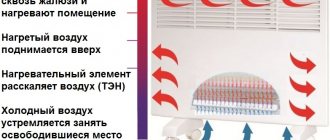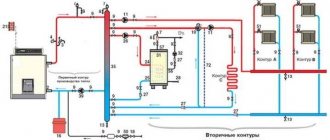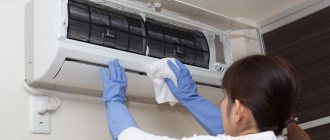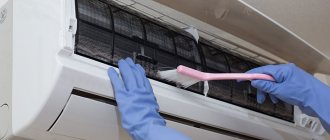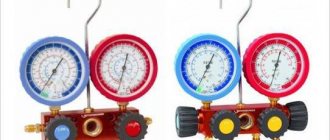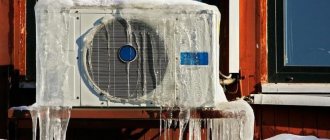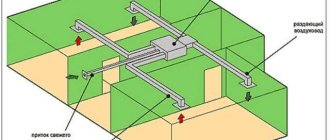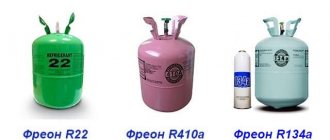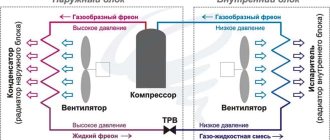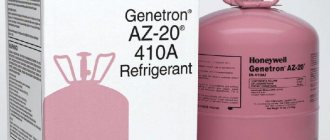What does freon do in an air conditioner? (+video)
Let's take a brief look at what exactly freon does in an air conditioner:
- The refrigerant leaves the evaporator as low pressure, low temperature vapor.
- The compressor increases the freon pressure to 15-20 atmospheres and the temperature to +70-90º.
- The refrigerant enters the condenser. There it cools and turns into a liquid state, and releases heat. In simple air conditioner models, this heat is removed outside the room. In models with heating - used to heat the room.
- Next, the freon enters the evaporator. Here its pressure decreases, and the freon boils and turns into gas. At this stage, the refrigerant releases cold, which cools the room.
That is, it is the freon circulating inside the air conditioner that cools and heats the air in the room.
When is refueling needed?
The main symptom is a decrease in productivity. However, you should consider all the main signs by which you can understand that the device needs to be refueled:
- Reduced air quality and cooling rate
- No cooling
- The appearance of oil on the refrigerant pipes
- Frost appears in the indoor unit.
If you notice that the indoor unit is covered with a large amount of frost, which even gets into the room, you should immediately carry out the refueling procedure. An air conditioning refill station can help with this.
What freon is used in household air conditioners (+ price of cylinders)?
There are about 40 different types of freons.
The following brands of refrigerants are used in domestic (home) air conditioners:
- R-407C. It is impossible to refill an air conditioner with such a refrigerant, since if it leaks, it changes its composition and loses its characteristics. Therefore, such split systems are only completely refilled (the old freon must be drained and then refilled with new one). An 11.3 kg cylinder costs about 6,500 rubles.
- R-410A. Unlike R-407C, it does not lose characteristics when leaked. Therefore, systems with this refrigerant can be topped up. A cylinder weighing 11.3 kg costs about 8,000 rubles.
- R32. In terms of thermal conductivity and performance - 5% more efficient than R-410A. It also does not need a complete replacement - if there is a leak, the system can be topped up without draining all the refrigerant. A cylinder weighing 10 kg costs about 8000-8500 rubles.
- R22. Since 2010, this refrigerant has been banned in the USA and Europe, since 2015 - in the Russian Federation (since it harms the ozone layer of the Earth). If you have an old split system, it can still work on this freon. New ones are already produced on other brands. Systems with R22 refrigerant can be filled with R-407C.
Prices are approximate, current as of March 2021 (at an exchange rate of 66 rubles per $1).
How can I find out the brand of freon in my air conditioner?
You can find out which freon is poured into the system in the following ways:
- Check the paper instructions for the air conditioner if you still have them.
- Look at the name of your model (on the plate on the side of the indoor unit, or in the instructions), and google the refrigerant characteristics.
- On the internal unit of the split system (which is installed indoors) there is a table with characteristics on the side. The type of freon is written there (Refrigerant).
Location of the table with characteristics on the indoor unit
How much freon is in the air conditioner, and how to calculate the amount depending on the length of the route?
Different air conditioners are charged with different amounts (volume) of refrigerant.
Table of standard indicators:
| Power class | Cooling capacity, kW | Approximate amount of refrigerant, grams |
| 7 | 2-2.2 | 500-750 |
| 9 | 2.5-2.8 | 600-750 |
| 12 | 3.3-3.6 | 800-900 |
| 18 | 5-5.4 | 1100-1200 |
| 24 | 6-6.4 | 1400-1700 |
This is for a standard route length. The length of the route will differ for different manufacturers and for air conditioners of different classes. On average - from 3 to 7 meters for models more powerful than 12. For 7-9 - the routes can be shorter. Exact data is indicated in the instructions for each model.
If the route is longer, more freon will be needed. For each extra 1 m we add 15-20 g for models of grades 7-9, and 20-30 g for 12-24.
How can you top up your split system?
There are two ways to refuel the installation at home.
These include:
- By pressure level. To determine the amount of gas that has evaporated, you need to know the optimal pressure (indicated in the instructions). It is then compared with the pressure in the air conditioner. To determine this, you need a collector. This method is used when there is a refrigerant leak due to prolonged use.
- By weight. The method is used when replacing freon completely. First, the refrigerant is removed from the system. Then, based on the weight determined on the electronic scale, the air conditioner is charged.
Reference! It is known that climate-class appliances during operation lose 8% of refrigerant in one year. For this reason, it is necessary to refuel every two years.
You can fill the unit using a measuring glass, but it is used extremely rarely.
How often and in what cases should the air conditioner be refilled?
The air conditioner needs to be recharged in the following cases:
- After installation or reinstallation to a new location.
- After repair, if the freon lines were disconnected during the process.
- If there is a leak from the circuit. Almost always the air conditioner has to be recharged due to a leak.
- Every 2 years (frequency is approximate, if the system is installed correctly, then less often is possible). On average, over 1 year of operation, about 8% of the refrigerant volume is lost.
You can tell when it’s time for a replacement by the quality of the device’s operation.
Signs of a leak are:
- frost appears on the outdoor unit;
- the room cools (or heats up) more slowly than before (at approximately the same outside temperature); At the same time, the air conditioner works longer (or without interruptions at all), and it has to be loaded more;
- the inverter model may often turn off and show a fault code;
- When the air conditioner operates, an unpleasant odor (not dust) appears.
Checking freon pressure in the air conditioner (video)
Price list 2021
Refilling the air conditioner (including) 25001 Vacuuming the system 20 minutes (work) 4002 Vacuum leak test 5 minutes (work) 3003 Refilling the air conditioner with oil (work) 2004 PAG oil (POE) 30 g (materials) 4005 Refilling the air conditioner with freon ( work) 4006 Freon R134a up to 1000 g (materials)800Refilling the air conditioner with freon more than 1000g. For every additional 100g (work + materials) 200Who does this and how much does the service cost?
Look for companies in your city that service climate control equipment - they can also replace the refrigerant or refill the system.
How much does such a service cost approximately (for a seven or nine class home air conditioner):
- refueling: from 1500 rubles;
- complete replacement: from 2500 rubles.
More precisely, only the master will tell you the cost. The price depends on:
- quantity and brand of refrigerant in your split system;
- condition of the air conditioner (if there is a leak, there is no point in refilling the refrigerant right away: it will leak again - so first diagnostics, repairs are carried out, and only then refilling).
Is it possible to charge the air conditioner yourself, and what do you need for this? (+video review of the refueling kit)
Yes, you can - the work is not difficult.
But it is unprofitable: freon is usually sold in large cylinders, and in addition to it, you will need to buy equipment for refilling. Therefore, in most cases it is better to pay a specialist than to work yourself.
But if you still decide to do it yourself, you will need:
- Hex set (or adjustable wrench)
- Set of Phillips screwdrivers.
- Digital scales (with a range of up to 15-20 kg).
- Pressure manifold (station). This is a measuring tool that controls the pressure in a split system. You can use a two- or four-position device. Four-position - more convenient and reliable. Cheap installation costs from 2600-2800 rubles.
- A freon cylinder of a suitable brand.
Step-by-step instructions for refilling the air conditioner with your own hands (+2 videos)
How to properly refill the air conditioner with your own hands:
- Open the window and inspect the outdoor unit. You need to find a casing on the side under which 2 hoses go.
- We unscrew the screws holding the casing, under which the 2 tubes go, and remove it. One tube supplies refrigerant in a gaseous state to the outdoor unit. The second tube removes liquid refrigerant from the outdoor unit.
- We drain the old refrigerant into the atmosphere - through the spool of the service port or through an unscrewed tube. Be sure to drain the freon slowly so as not to drain the oil as well. For replacement at home by an inexperienced person, this is the most acceptable option: you are unlikely to be able to correctly calculate the remainder for refueling.
- We connect the left (blue) hose of the pressure gauge station to the spool.
- Check that the manifold valves are closed.
- We connect the middle (yellow) hose of the pressure gauge station to the fitting of the vacuum pump.
- Open the low pressure valve and monitor the readings: you want the pressure gauge to show -1 Bar.
- Open the service port valves.
- We vacuum the circuit for 20 minutes. When the pressure drops to -1 Bar, wait another 20-30 minutes: won’t the needle rise back to 0? If it does, it means there is a leak somewhere in the circuit. It must be found and fixed, otherwise the charged refrigerant will leak again.
- If no leaks are found, 30 minutes after evacuation, disconnect the yellow hose of the station from the pump and connect it to a cylinder with freon.
- Close the left manifold tap.
- We put the freon cylinder on the scale and remember how much it weighs now.
- Open the valve on the cylinder.
- We open for 1 second and then close the right valve at the pressure gauge station - to blow out the rods (so that there is no air left in the hose that will enter the circuit).
- Open the left (blue) tap at the station. After this, freon will begin to flow from the cylinder into the air conditioner circuit. The weight of the cylinder will begin to decrease. We monitor until it drops to the required level (that is, until the circuit is filled with as much gas as needed for your model), and turn off the blue tap.
- We turn off both taps on the unit, disconnect the station and check how the air conditioner works.
Installing an air conditioner on an old highway
The main requirement for the line is that the tubes inside are clean and free of water and air. Therefore, the masters approach the implementation of the task fully armed. That is, they must have a pressure gauge, a vacuum pump or compressor and a supply of freon of the required brand.
Dismantling old blocks
If the old air conditioner is in good technical condition, then the technicians do everything to ensure that the refrigerant is pumped into the external unit, freeing the route completely. This air conditioner can be used in other rooms. After which the parts of the split system are disconnected from the main line by unscrewing the union nuts located on the copper tubes. If the compressor in the device burns out, the tubes are simply disconnected and the refrigerant is released into the street.
- The drainage corrugation is disconnected from the external unit, as well as the electrical wiring connecting it to the outer part.
- The inner part is removed from the bracket, which is fixed to the wall with self-tapping screws through plastic dowels. Please note that the old bracket may not fit the new air conditioner in terms of installation dimensions. If this happens, then remove it and install another one that came with the new device.
- The external unit is installed on two brackets and secured to them with bolts. The latter must be unscrewed to remove the device.
- Don't forget to disconnect the electrical wires from the terminal box.
In principle, this completes the dismantling.
A few words about the wires connecting the external and internal parts of the split system. If, when replacing old equipment, a unit with the same power consumption is installed, then the wiring does not need to be changed. But here we need to think about something else. Although the wires are covered with insulation, their long operation under load reduces their service life. Therefore, there is always a possibility that they may fail in further operation.
Installation of a new split system
Now everything needs to be done in reverse order.
- Installation of two blocks. A new bracket is installed for the internal one.
- They are connected to the main line and to the electrical main. Drainage is connected to the internal one.
- Vacuuming. This is pumping out air and moisture, as well as particles of dirt and dust, from the route. For this, a special vacuum pump or an old air conditioning compressor is used. The equipment is connected to the main line through a tap on the external unit. The air must be pumped out for half an hour, then the pump is turned off. After that, you need to monitor the pressure gauge connected to the air conditioner through a vacuum pump for another half hour. If the arrow fixed in one position has not moved, this indicates that the main system is completely sealed. If it has shifted, then you need to look for the leak.
- The vacuum pump is disconnected.
- Two valves on the external unit open, through which refrigerant is supplied to the system. You need to unscrew the valves with a wrench slowly and forcefully. There should be a hissing sound. This freon began to move and fill the system.
- As soon as the hissing stops, you can test the split system by running it in all modes.
Precautions when working with freon
If you are planning to refill the air conditioner yourself, remember:
- Brands containing chlorine are harmful to the body. Avoid contact with mucous membranes (eyes, mouth), and do not inhale them.
- If there is a high concentration of freon, you can get poisoned. Therefore, do not work indoors - be sure to open the window and door, and if there is one, turn on the hood (in the kitchen and bathroom).
- If liquid freon gets on your skin, you can get frostbite. Therefore, you only need to work in rubber gloves and closed clothing (not a T-shirt or a T-shirt with shorts).
If during operation the coolant gets on the skin or mucous membranes, it should be immediately washed off with water and the area should be lubricated with Vaseline.
If symptoms of suffocation or any other abnormal signs occur, you must immediately stop working, leave the room and ventilate it.
Why do you need a screen for an air conditioner, and how to make it yourself?
What is a cabinet air conditioner: overview, scope, functions
